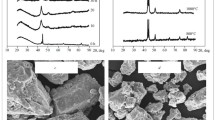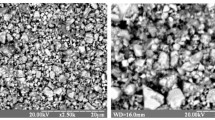Summary
-
1.
Sintered copper produced by repeated pressing and sintering at low temperatures is markedly superior to cast commercial copper in hardness and resistance to compression.
-
2.
High-temperature sintering is not essential for obtaining powder copper with a minimum pore content. Low porosity may be attained by repeated compaction and annealing at relatively low temperatures.
-
3.
The mechanical properties of sintered copper increase with decreasing sintering temperature. When materials obtained at different sintering temperatures are compared with one another and with cast copper, it is found that the greatest difference in the resistance to compression is observed at low degrees of deformation.
-
4.
The deterioration of mechanical properties and improvement of ductility at higher sintering temperatures may be explained by grain growth and a coarsening of the block structure.
-
5.
The X-ray diffraction method of studying recrystallization, involving determination of the number of spots on interference lines in X-ray photographs, fails to detect the process of collective recrystallization during the sintering of compacts from electrolytic copper powder at up to 1000°C.
Similar content being viewed by others
Literature cited
K. V.Savitskii et al., Izv. Vysshikh Uchebn. Zavedenii, Fiz., 6,57 (1962).
B. Ya. Pines and A. F. Sidorenko, Izv. Vysshikh Uchebn. Zavedenii, Fiz., 1,23 (1960).
A. B. Middleton, L. B. Pfeil, and E. C. Rhodes, J. Inst. Metals, N 3, 75 595 (1949).
I. M. Fedorchenko and R. A. Andrievskii, Principles of Powder Metallurgy [in Russian] Kiev, Acad. Sci. Ukr. SSR Press, (1961).
P. Coulomb and J. Friedel, Dislocations and Mechanical Properties of Crystals [Russian translation] (1960) p. 366.
K. V. Savitskii, V. N. Zhdanova, A. P. Savitskii, and V. A. Kulikov, Collection: Investigations of Heat-Resisting Alloys [in Russian] Moscow, Acad. Sci. USSR Press, 9 (1961) p. 119.
H. H. Hausner, J. Metals, N 3, 331 (1957).
V. N. Zhdanova, A. P. Savitskii, and V. I. Stolyarova, Izv. Vysshikh Uchebn. Zavedenii, Fiz., 2 17 (1958).
V. I. Iveronova and N. N. Osipenko, Fiz. Metal i Metalloved.,10, 736 (1960).
I. M. Fedorchenko, Problems of Powder Metallurgy and Strength of Materials [in Russian] Kiev, Acad. Sci. Ukr. SSR Press, 1 (1954).
G. V. Kurdyumov and M. D. Perkas, Collection: Investigations of Heat-Resisting Alloys [in Russian] Moscow, Acad. Sci. USSR Press, 9 (1962) p. 3.
Author information
Authors and Affiliations
Rights and permissions
About this article
Cite this article
Savitskii, A.P., Zhdanova, V.N. & Girya, É.N. The effect of sintering temperature on the strength of powder copper subjected to repeated pressing. Powder Metall Met Ceram 3, 311–315 (1964). https://doi.org/10.1007/BF00774176
Received:
Issue Date:
DOI: https://doi.org/10.1007/BF00774176




